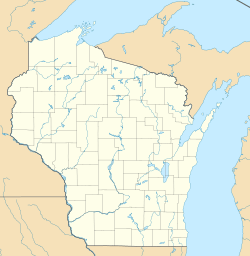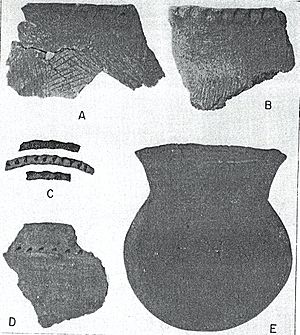Bell site, Wisconsin facts for kids
Quick facts for kids |
|
|
Bell site (47 Wn-09)
|
|
| Location | south side of Big Lake Butte des Morts, Winnebago County, Wisconsin |
|---|---|
| NRHP reference No. | 92000818 |
| Added to NRHP | 1992 |
The Bell site (also known as 47 Wn-09) is an important archaeological spot. It is located on the south side of Big Lake Butte des Morts in Winnebago County, Wisconsin. This site is about 52 miles southeast of Green Bay, Wisconsin.
Archaeologists believe the Bell site was an early village of the Meskwaki (Fox) people. They lived here between about 1600 and 1750 AD. Studying this site helps us learn about the lives of Native American groups long ago.
Contents
Discovering the Bell Site
The Bell site was first found in 1911. This happened during gravel mining operations. Workers found ancient burials, which caught people's attention.
In the 1950s, professional archaeologists became interested. They noticed that people were finding old items from both historic and prehistoric times. The pottery found here was different from any other pottery seen in Wisconsin.
Experts thought this might be a village of a Central Algonkian tribe. These tribes were originally from Michigan or Ontario. They might have moved during the Beaver Wars in the 1600s. Later research showed that early French explorers had written about a Meskwaki village in this exact spot.
Digging for Clues in 1959
In 1959, archaeologists began digging at the Bell site. This work was a team effort. The State Historical Society, the Wisconsin Archaeological Survey, and the Oshkosh Public Museum all helped. Warren L. Wittry from the Cranbrook Institute of Science led the project.
What They Found
The digs helped archaeologists find many interesting things. These are called "features" at an archaeological site:
- The remains of a palisade, which was a strong defensive wall.
- 45 pits used for storing food or throwing away trash.
- A bear skull placed in a special way. This suggests an old practice of honoring bears.
- A burial of three dogs. This might show an early practice of special dog burials. Similar dog burials have been found in Michigan. Early French explorers also wrote about this practice among Great Lakes tribes.
- One human burial. Several other burials were found when the site was first discovered in 1911.
- Several "post molds." These are marks left in the ground where wooden posts once stood. They suggest where houses or other structures might have been.
Tools and Treasures
Archaeologists found a wide variety of artifacts. These are objects made or used by people in the past. They included:
- Tools and items made from bone and antler.
- Objects made of brass, glass, iron, and lead.
- Pottery pieces and even a complete pot.
- Stone tools, some ground smooth or polished.
- Items made from shells.
- Smoking pipes.
Ancient Pottery Styles
The archaeologists found four main types of pottery at the Bell site:
- Bell site type 1: This was the most common type. It had a smooth surface and was made from clay mixed with grit. The pots were round with rims that flared outwards. They often had decorations like dots and carved lines. Some even had strap handles. This pottery has also been found in Illinois and Michigan. It is believed to belong to the Meskwaki people.
- Bell site type 2: This pottery was also made with grit. The pots were round with outward-flaring rims. The outside surface often had cord marks from the neck down. The neck area was very smooth. The only decoration was often finger-crimping on the rim. This type has been found in Door County, Wisconsin. It is thought to be from the Potawatomi people.
- Lake Winnebago focus: Only a few pieces of this pottery were found. It was made with shell mixed into the clay and had smooth surfaces. This type is linked to the Oneota culture. It is believed to be from a Siouan-speaking group, possibly the Ho-Chunk people.
- LaSalle filleted: Only three rim pieces of this type were found. It was grit-tempered with a cord-marked surface. It also had raised strips (fillets) and strap handles. This pottery has been found in the Starved Rock State Park area of Illinois.
Why the Bell Site is Important
It can be very hard for archaeologists to connect ancient Native American cultures to the tribes we know today. When Europeans first arrived, many tribes were moving around. This was due to wars, like the Iroquois wars, and new trading patterns. Because of this movement, it's tough to know exactly where tribes lived in prehistoric times.
Also, after Europeans arrived, tribes started trading for new items. They got brass kettles and steel knives. These new tools replaced their traditional pottery and stone tools. This meant that the old ways of making things slowly disappeared. This created a gap in the archaeological record between prehistoric and historic times.
The discovery of the Bell site was a big deal. For the first time, archaeologists could see Meskwaki culture in an undisturbed, early historic setting. The Bell site type 1 pottery is clearly linked to the Meskwaki tribe. This is because it was the most common pottery found there.
Later, digs at a known Potawatomi site (Rock Island) found Bell site type II pottery. This showed that the Potawatomi made that type of pottery. In both cases, these discoveries were the first time specific pottery styles could be confidently linked to these tribes. This helps us understand their history much better.




